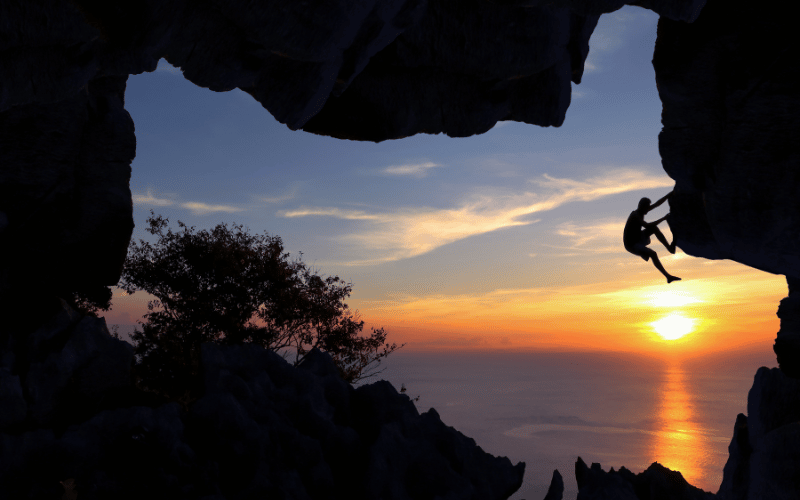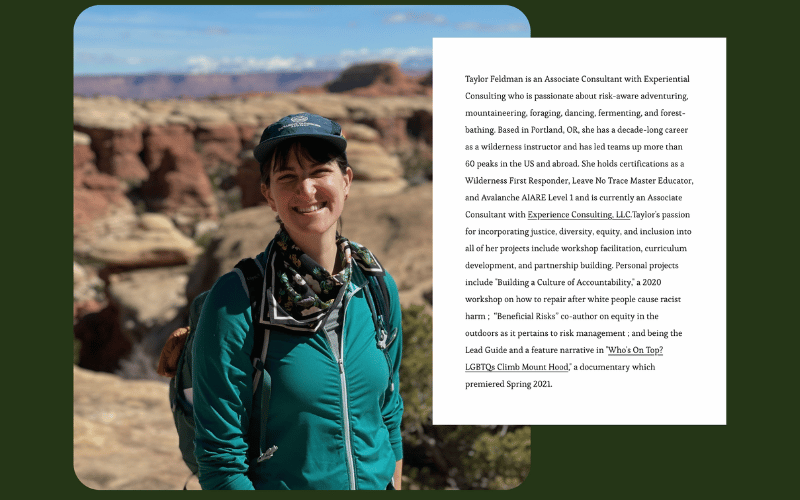
Language is alive. All humans depend on ever-evolving languages and their ability to grow and change to better reflect our cultural contexts. Language, like our natural world, has been tended to and curated by people for millennia. Much like natural resources, there are sustainable and unsustainable practices. Knowing the histories of the words and terms we use is an essential step in writing and one that now may be easier through Taylor Feldman’s Inclusive Outdoor Language Guide.
Feldman first became interested in sustainability while in high school. Having grown up in Chicago, IL, Feldman immersed herself in city life and hadn’t engaged in the types of outdoor activities that would later define her career.
Her interest in environmentalism led her away from the bustling, concrete city on a lake to Evergreen State College in Olympia, WA. There, she made friends with a group of climbers, who taught Feldman how to rock climb and hike in ways that she had never been exposed to before. By her junior year, she went to Patagonia for six months through a NOLS program, and learned backpacking, mountaineering, rock climbing, sea kayaking as well as earning Wilderness First Responder and Leave No Trace Master Educator certifications.
Though she might not have known it then, these experiences in college forged the pathway for her career, taking her across the world climbing different peaks.
Feldman served as a Wilderness Instructor for ten years at the Oregon Episcopal School, an Environmental Educator at Audubon Society of Portland, and was a contributor to the book Beneficial Risks. She also was one of the four cast members of the documentary “Who’s On Top”, highlighting the journey of four queer athletes climbing Mount Hood. These are just a few of Feldman’s fascinating accomplishments. Currently, Feldman is an Associate Consultant with Experiential Consulting, an organization focused on informing the outdoor community on risk-aware adventuring.

Beyond environmental uncertainties
For Feldman, there was a big gap that people weren’t aware of in risk management. She found that there were shining DEI statements and risk management plans, but they weren’t talking to each other. Feldman noticed that risks are not limited to environmental uncertainties, but social ones too.
What happens when outdoors people encounter psychologically or emotionally risky situations? For example, someone yelling racial slurs at a person of color while hiking a trail. What steps can be taken to deescalate the situation and how can the outdoor community be better prepared when these risks occur? This led her down a series of projects, including the Inclusive Outdoor Language Guide, which will now be a resource available on OWAA’s website.
Feldman wanted a guide that reflected the dynamic world of language. Having the guide exist on a Google Sheet allows it to undergo edits and changes, leaving room for the outdoor community to share their own insight to problematic words or phrases and continue building this resource. In this form, it can be virtually tended to by the community and updated faster than a published guide could be. Upon opening the document, you might notice some terms are not strictly limited to the outdoors, but are nonetheless important words for outdoors people to know.
Currently, the guide is community generated, meaning anyone can contribute a word or phrase that is then filtered through Feldman. Feldman notes the project is still new and recognizes the flaw in one person filtering through the submissions. However, as the guide grows, the group of reviewers may also grow. At the same time, Feldman seeks to keep the guide as tailored to the outdoor community as possible. Ultimately, Feldman prioritizes the terms on this list to be things that have historical, problematic roots. Feldman explains, “…The people that have less power are the ones that I want to give more voice to.”
Perhaps the most important feature of this guide is its ability to help us educate ourselves on potentially lesser known histories of phrases or words that are regularly used outdoors. As writers, the last thing we want to do is unintentionally offend our subjects or readers. Feldman explains, “if you’re going to use [the guide], use it intentionally. Know that you’re making a choice in your language and you’re not just being passive.”
This guide may invoke some difficult conversations with ourselves and our peers. However, Feldman mentions,
“If you enter any conversation and you’re humble about what you do and do not know, and you’re also curious about what the other person has to say, that can get you pretty far in terms of uncomfortable conversations or conflict.”
Why the Inclusive Outdoor Language Guide is helpful
So what does the Inclusive Outdoor Language Guide do and why is it important or helpful to outdoor media professionals?
Steven Griffin offers some insight on his use of the guide. A long time OWAA member and member of OWAA’s DEAI Committee, “Griff” brings several decades of writing experience, as well as 10 years of teaching as an adjunct professor in Central Michigan University’s journalism department.
Much like Feldman’s note on intentionality, Griff said “I want the words to do what I want them to do. Each has a very specific task, with origin, flavor and connotation all playing parts in meeting that task.” The Inclusive Outdoor Language Guide can help, providing a richer context of words and phrases for outdoor communicators.
“Also, looking at the guide helps me empathize with the people who might be offended by a term,” added Griff.
“When we talk about writing, we talk about it being composition. We’re not inventing new words. We’re just assembling them in a certain way. And that is as much craft as it is art. That means selecting things carefully. This guide can help us do that.”
Steven Griffin
For Griff, this resource is not meant to be authoritative and makes a helpful addition to other style books he uses.
“I’ve worked from the AP Stylebook, different publications’ stylebooks, Chicago Manual of Style, and I have not followed them 100% ever,” Griff said, “But when I varied from them, it was on purpose.”
As environmentalists and outdoor communicators, we understand that our ecosystems are constantly changing and evolving, especially in the face of climate change. We also understand that humans are notoriously bad at long term planning, making sustainability a difficult feat. Nonetheless, this doesn’t stop us from working towards making wiser, intentional, well-informed choices for a more sustainable future. A necessary step towards sustainability is recognizing the intentional and unintentional malpractices of the past. The same goes for language.
Feldman’s Inclusive Outdoor Language Guide offers a starting point for learning about the history of words with problematic roots. A salve for these troublesome terms is learning these histories so they no longer spread harm.
Here are a few examples of outdoor inclusive language you’ll find in Feldman’s guide.
| Problem Words or Phrase | Suggested Alternatives | Definition | Why it’s problematic | Reference/Resource Link | When, if ever, is it okay to use this word or phrase? |
| Biner (as in carabiner) | Carabiner | Metal loop (usually aluminum) with a spring-loaded gate on one side used for connecting various parts of a climbing system. | The “biner” slang word for carabiner can be offensive to people of Mexican descent and heritage. While the spelling of the climbing slang term and racial slur are different, they are audibly identical. | http://www.latina.com/lifestyle/our-issues/ethnic-slur-beaner-meaning-history | No |
| Jerry-rigged, Jury-rigged | improvised, poorly designed, skewed, MacGyvered | “Jerry-rigged” means organized or constructed in a crude or improvised manner. A Jury Rig is a knot used to tie an oar onto a broken mast to rig up an improvised fix in order to be able to sail to shore or another safe location for repairs. | “Jerry” is a derogatory term used by soldiers and civilians of the Allied nations for Germans in WW2. In the segregated 1950s this term was used to describe shoddy workmanship in the auto industry as a derivative of “n*-rigging”. | https://en.wikipedia.org/wiki/Jury_rigging | |
| Crippled (with fear etc.) | Fearful, unable to move | A person with a physical or mobility impairment | Ableist |
OWAA’s Diversity, Equity, Accessibility and Inclusion (DEAI) Resources
OWAA welcomes, respects, and supports all communicators, particularly those from underrepresented communities who are involved in or wish to become involved with sharing the outdoor experience.
OWAA strives to advance the professional goals of its members and potential members by encouraging dialogue and providing resources that reflect the values of justice, equity, diversity, inclusion, accessibility and open-mindedness. It also aims to increase opportunities and encourage involvement in the outdoors by all.
CLICK HERE to view all of OWAA’s DEAI resources and learn even more about outdoor inclusive language.
